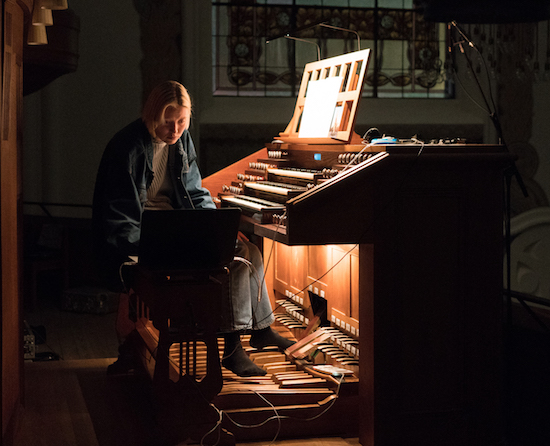Ellen Arkbro’s new album, CHORDS is uncompromising. There are two tracks. ‘CHORDS For Organ’ is simply nine interlocking organ chords spread across 16 minutes. ‘CHORDS For Guitar’ is a sequence of eleven bright, clean electric guitar chords, each strummed ten times. In each, synthesis adds disconcerting, non-standard tunings.
Initially, it is alien, harsh, confusing. ‘CHORDS For Guitar’ comes across like PC Music attempting acoustic meditation. Then the ear adjusts, the brain locks into the logic of Arkbro’s tunings. A whole new aural universe opens up; there is no going back.
Present-day music is typically tuned using equal temperament, with 12 notes distributed equally across the octave. Whilst this has musical advantages, it is an artificial and, some would argue, ugly compromise. Arkbro explores what happens when you follow pitches to where they naturally sit, both in terms of the ear and the mathematics of pitch. Her previous album For Organ and Brass used an antique organ tuned to meantone intonation, a historical tuning system which accentuates thirds. The rich, plangent tones of the organ and the brass trio of the title are like Satie released from the drawing room to gaze up at the stars
CHORDS is more formal. It utilises the psychoacoustic effects, the way the nature of our perception of sound changes, of certain precise tunings where the relationship between pitch frequencies determined by ratios containing only whole numbers, what Arkbro calls “in-tune-sounds”. If the technique is akin to how the experience of a Bridget Riley artwork is more than the sum of its dots or lines, the way Arkbro deploys this feels more like the luminous peace of one of Agnes Martin’s grids.
Ellen Arkbro grew up in Stockholm, Sweden. As a teenager, she dragged her female bandmates to twice weekly rehearsals of skate-punk covers, and, soon, her own compositions, in the basement of her local Baptist church. A keen interest in jazz (John Coltrane, Miles Davis, Wayne Shorter) led to her enrolling in a residential jazz college in the south of Sweden where pupils were encouraged to play day-in day-out, barely interacting with the outside world.
The jazz school didn’t work out. Arkbro took a course at Stockholm’s state-run Elektronmusikstudion (also known as the EMS). She encountered Supercollider, the text-based programming environment she still uses to generate sound. She went on to complete a degree in electro acoustic composition at the Royal Conservatoire in Stockholm.
Arkbro also studied with minimalist originator La Monte Young and his wife Marian Zazeela, whom she was introduced to by her partner, Marcus Pal. Young is as notorious for structuring all aspects of his life (and those of associates and pupils) towards his art as he is for protecting his privacy. While Arkbro talks with enthusiasm and passion about her time studying with him, she is also careful to preserve confidences.
Arkbro speaks to tQ via Skype from her white-walled clutter-free Stockholm apartment, followed by email exchanges. Discretely circumspect about personal matters, when discussing music, she is inquisitive, engaging and considered, concerned only to that her (excellent) English might not express her ideas with the precision of her music.
How do you describe the music you are currently making?
Ellen Arkbro: I think about it as slow music focusing on a certain type of sound, or rather a very specific experience of it: that moment when an in-tune-sound somehow becomes one with the space which you are listening in. This is my very conceptual idea of it. [Laughs] I don’t know whether it is close to what people actually experience.
Does that mean your pieces are site specific?
EA: Yes, completely and that’s how these sounds need to be experienced. So in a sense it is a little bit strange with this latest music to actually put it out on a record.
You perform a lot in churches. Why? How does your music fit with the reactions your audience might have to this particular type of space?
EA: I started playing in churches because that is where you find organs! Then I realised that I really enjoy it. But it is a complex thing. People have very different relationships with that kind of space. What I enjoy about being in a space like that, and I can only talk about my experience of it, is the sense of gentleness. Something happens when people enter a church. They get a little bit quieter and a little bit more aware of their surroundings, and of other people. Of course if people are distracted by other thoughts and feelings when being in that space then it is not a good listening space.
Are you working with the psychology of a space rather than just the acoustics?
EA: Of course. I think I do it unconsciously. I don’t really know, in a space like that, how I come to make the decisions that I make, but I know that it is very different from being in other spaces. There is a certain moment after I have arranged everything, after I have played the organ, adjusted the synthesis, fine-tuned everything and I look out and [think] “Oh, we’re in a church. Jesus is over there hanging on a cross. How do I relate to this?”
Is your music spiritual?
EA: [Immediately] Yes! But that aspect of the experience of the music is not something that I would ever talk about. It is not spiritual by default, but it can become spiritual music in the listener. To me, I feel that the spiritual experience is not happening when I listen to it, but rather when thinking about it after listening.
How did you become interested in different tunings?
EA: La Monte Young was my way into it. Someone played me The Well-Tuned Piano. The concept of working with tuning and intonation was not so foreign to me because I had been singing a lot of Swedish choir music and playing a lot of jazz, so it felt natural. In choir music the intonation aspect is often not explicit but it is happening naturally.
But you know how it is when you discover something new: I was getting closer to it on my own somehow. Then suddenly you hear the music that you have been dreaming of hearing and moving towards.
For you, what is important about the music of La Monte Young?
EA: It has such clarity and intense feeling to it. When you get into tuning there are a lot of concepts and theories that you can get excited about and easily get lost in. You get absorbed in theories and ideas and you forget all about the experience, the sound, the music. La Monte is such a great musician. There is a deep complexity in many of his sounds, it feels like you can almost touch the textures. But then there is also this soul; it’s so extremely soulful, and in that way really simple.

What was it like studying with La Monte Young and Marian Zazeela?
EA: One of the most important lessons was learning how they live. They are so extremely devoted to the music and the art that they are making, to an extent that you can’t really imagine. That was crucial to me. I remember the intense feeling of that experience still. I couldn’t imagine it until I experienced it with them. It is a radical thing that they are doing and it is important to remember that they are trying to do the impossible.
For someone to say "I will teach you" and to invite you into that very sensitive personal space, it is such a precious gift to be given by someone. The intensity of that experience stays with me.
Returning to tunings, the composer Lou Harrison, normally one of the most gentle Californian of souls, said ”Equal Temperament destroys everything and is not fit for the human ear”…
EA: [Laughs] I don’t know about that! Of course, equal temperament has a sound. It is not very appealing to me either, especially if you are searching for the in-tune-ness of sound. Then you will be disappointed, because it doesn’t exist in equal temperament. But I actually wrote a piano piece last Fall. I wasn’t planning on writing it. We got a piano, the piano I grew up with, which I played when I was little. I was sitting there playing it again and found really interesting harmonies, certain textural qualities of certain clusters and intervals that resembled the complexity of the very in-tune-sounds that I have been listening to a lot. Eventually I was like” Oh! Is this a piano piece?” There is something very poetic about the sound of a piano because it is striving for something and it never happens. So I wouldn’t express myself as strongly as Lou Harrison.
My particular interest right now is the texture of the in-tune-sounds. That is what I am most excited about. I don’t know whether that is something to be excited about if you are new to these types of sound or if you like to identify the notes and analyse the chords. But, for me, especially with the new record, it is the textures.
Why the organ?
EA: It has a fascinating sound. I wrote a couple of piece for electric guitar, tuning the strings, processing the sound of it and I found myself wanting to make the guitar sound like an organ until the point where I realised that, maybe, it would be an idea to work write for organ. Since I was interested in tunings, I wanted to work with the meantone organ in Gamla Stan in Stockholm. As I was playing the instrument I understood that this is a whole world of instruments that I needed to explore further. It’s such an interesting object, such a complex instrument, that has taken people so many many years to build. Every instrument is different and is built for a specific space, and you have to travel there to hear it. Somehow it made so much more sense than bringing your laptop and plugging it into two speakers.
A lot of your music, particularly the piece on the album seem meticulously structured.
EA: I don’t know much about composition but I feel confident when I work with form. [Laughs] To me, structure is everything. With ‘For Organ And Brass’ I didn’t have to think too much about it, I felt as if I knew the music and just had to write it down. But with other pieces I spend a lot of time listening to it and feeling it. Should it switch here? Should there be two more repetitions? I’m not very sure but it is very important that a chord change is happening when it’s time for it, not before, not after.
Ellen Arkbro is part of the Tusk Festival line up, held in Gateshead 11 – 13 October


